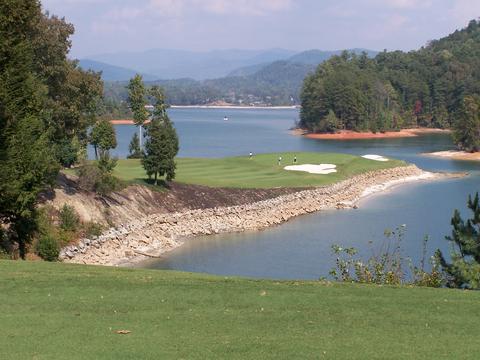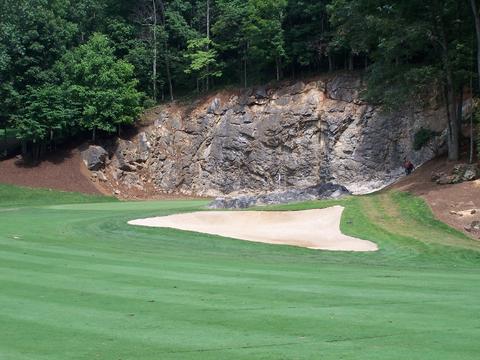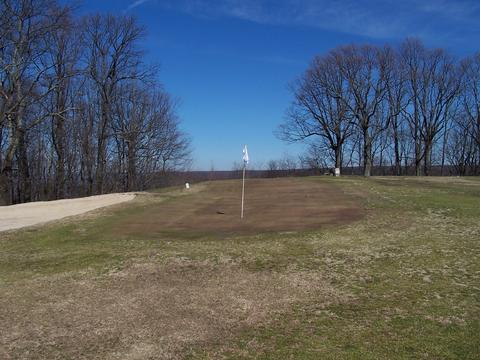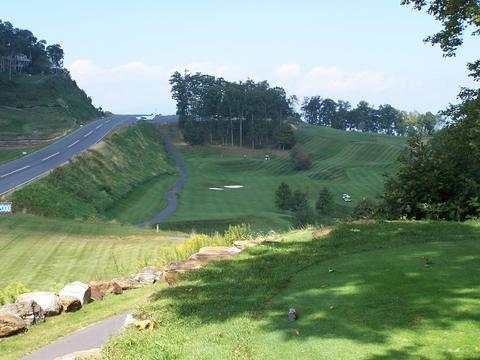In researching golf courses and the communities that surround them, I have been fortunate to play more than 1,350 holes of golf over the last two years. To ensure my objectivity, and lest anyone think I have an elaborate scam going, I paid for every round, often arguing with pro shop staff that had been instructed by their real estate counterparts to provide me with complimentary greens fees. My comments at this site and in the HomeOnTheCourse community guide are happily free of any marketing hype.
Overall, I have gotten my monies worth in these two years. I have played very few clunker courses, and some courses and golf holes have been memorable. Below are photos and short descriptions of some of the best holes I've encountered.

The signature par 3 12th at Tennessee National certainly is one of the best holes that Greg Norman has ever designed.
Some memorable holes in unforeseen places
The most memorable hole of my last two years on the road actually was one I did not play. The course at Tennessee National, a high-end community with lot prices in the mid six figures and about a half-hour from Knoxville, TN, was about two months short of being open for play, but it was clear that the Greg Norman layout had the makings of a classic. Its signature hole, as most signature holes are, is a par 3 that maximizes the twin features of water and sand. Wisely Norman and his fellow developers from the Medalist Company placed the tee box close to the main drive into the community. It is impossible to drive by without stopping for a look (and in my case, the photo above). Not surprisingly, the community's web site and promotional literature feature Mr. Norman about to strike his tee shot on the 12th toward the green below.
From the back tees, the hole plays downhill 209 yards, with the shorter tees playing to 187, 166, 142 and 123. Eight deep bunkers, with sod faces, surround the green, four of them pot sized and built into the face of the slope in front. Hit short, and you could fall back down the slope into a creek that feeds the Tennessee River, which runs along the entire right side and below the green. Any pushed tee shot will be lucky to find one of the two bunkers there; hit the slope between the bunkers, and you will be playing your third shot two club lengths from the water. The only bailout opportunity is to the slope left of the green, but that will necessitate an uphill pitch shot to the pin. In two years, I've seen no finer, or intimidating, par 3 than the #12 at Tennessee National. Norman's organization has a nice array of photos of Tennessee National and his other courses at www.shark.com .
I'd love to have another shot (literally) one day at the 17th at Tom Fazio's Keowee Vineyards course for The Cliffs Communities. A few years ago, the par 3 was the toughest hole on the Nationwide Tour in relation to par (closer to playing as a par 4 than a par 3). Although I had no business playing the hole from the tips, I had to try the  downhill shot to the green some 270 yards away (the elevation probably made it play about 250). I hit driver short and left of the green, away from the lake on the right, and considered myself lucky to be left with a 20-yard pitch to a pin that was front left. I made the putt from inside 10 feet for par but fought back the urge to sign up for the Nationwide Tour right then and there.
downhill shot to the green some 270 yards away (the elevation probably made it play about 250). I hit driver short and left of the green, away from the lake on the right, and considered myself lucky to be left with a 20-yard pitch to a pin that was front left. I made the putt from inside 10 feet for par but fought back the urge to sign up for the Nationwide Tour right then and there.
Another memorable hole was perhaps the quirkiest, a par 5 at Red Tail Mountain in Mountain City, TN, located between Boone, NC and Knoxville. The par 5 12th at Red Tail starts from a tee box framed by a chute of trees. A large hump runs 50 yards down the landing zone area in the fairway; anything on the left or right side of the fairway will continue in that direction and into the rough. It almost doesn't matter, since the next shot is a  medium iron lay-up to the right angle of the fairway, just 100 yards from the green. Hit too far, and you wind up in a sand bunker at the elbow. Hit too short, and a tall, dense group of trees blocks your access to the most unusual green I encountered in two years (maybe ever). Guarding the right front of the putting surface is a large rock outcropping; hit it and you could wind up anywhere, including straight back in your direction. Behind the entire green is a rock wall about 30 feet high; it is an unreliable backstop as balls hit over the green bound in most directions other than onto the green. As you stand in the fairway awaiting your approach shot, you wonder what mad genius conceived the hole. (The answer? The typically mild mannered Dan Maples).
medium iron lay-up to the right angle of the fairway, just 100 yards from the green. Hit too far, and you wind up in a sand bunker at the elbow. Hit too short, and a tall, dense group of trees blocks your access to the most unusual green I encountered in two years (maybe ever). Guarding the right front of the putting surface is a large rock outcropping; hit it and you could wind up anywhere, including straight back in your direction. Behind the entire green is a rock wall about 30 feet high; it is an unreliable backstop as balls hit over the green bound in most directions other than onto the green. As you stand in the fairway awaiting your approach shot, you wonder what mad genius conceived the hole. (The answer? The typically mild mannered Dan Maples).
I played only one 9 hole layout in the last two years, during a visit with my son to look at the University of the South in Sewanee, TN. The Sewanee Golf Club course, which was built by faculty, students and local residents in 1915, traversed a hardscrabble, up and down routing that I found a bit of a trek on a cold February day. Sewanee was golf au naturel, with no more than a half dozen sand bunkers, but what it may have lacked in modern touches it more than made up for in its classic use of terrain. Few fairways were level, and Sewanee's small greens were all best approached by run up shots; the turf on the greens was almost as firm as that of the fairways (the course has no irrigation system). Two putts were a blessing on any hole, none more than the unforgettable 4th, a 160-yard uphill par 3 to the narrowest green I had ever played, less than 20 feet across its front and not much wider at any other point. We were fortunate the pin was up front; the very back of the green was a mere four paces to the edge of the mountain. The only benefit to hitting the ball over the green would have been the breathtaking views of the valley below and the Smoky Mountains dead ahead. It was an unforgettable hole on a golf course that time has forgotten, but I won't.
hole, none more than the unforgettable 4th, a 160-yard uphill par 3 to the narrowest green I had ever played, less than 20 feet across its front and not much wider at any other point. We were fortunate the pin was up front; the very back of the green was a mere four paces to the edge of the mountain. The only benefit to hitting the ball over the green would have been the breathtaking views of the valley below and the Smoky Mountains dead ahead. It was an unforgettable hole on a golf course that time has forgotten, but I won't.
The private, gated community of Mountain Air in Burnsville, NC, is a favorite of well-heeled pilots because an airstrip runs through it, and through the heart of the golf course as well. At more than 4,000 feet, there is plenty to distract the golfer's eye, but nothing more so than the sight of an airplane taking off below your tee box or beside the green you are putting on. The strip is not exactly in play, but a dramatically pushed or pulled drive on one of the adjacent holes could, ahem, really take off.

There is a fine line between quirky and dramatic along the runway at Mountain Air.



